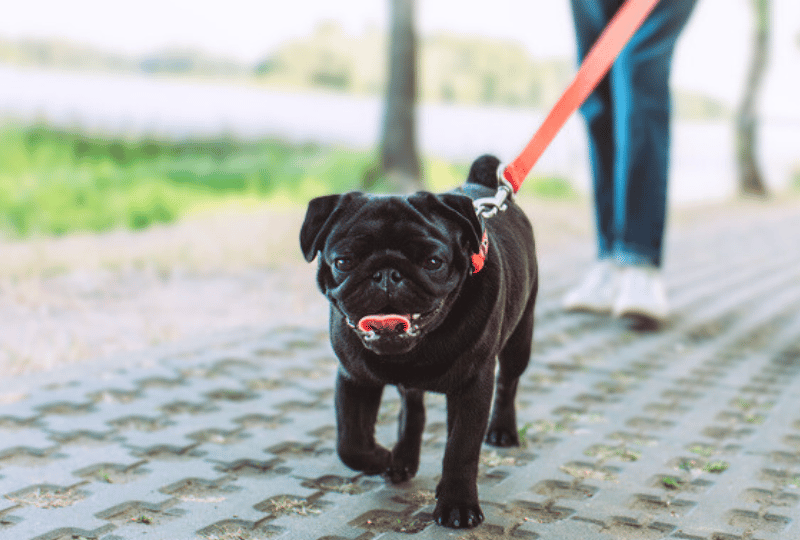Walks with your dog are supposed to be fun! The two of you are bonding, walking at your own pace while enjoying the fresh air. Walking my dogs is certainly one of the best parts of my day. We both benefit from daily walks since exercise is good for our joints and it is mentally enriching.
However, walking your dog becomes a lot less fun when they refuse to walk in certain directions. Whether they lay down in the middle of a walk, pull you the opposite way, or simply plant their feet and refuse to move with you, it can be frustrating and ruin the moment.
Dogs refuse to walk in certain directions because they lack socialization or training. They might get easily distracted and have trouble listening. It’s also possible that your dog had a bad experience or might be scared of something in that area. Finally, they might be tired, sore, or sick.
We’ll take a look at each explanation, help you figure out which explanation makes the most sense for your dog and explain what you can do about it.
Reason 1. Your Dog Needs More Socialization
According to the Animal Humane Society, “Socializing your dog… is one of the best ways to ensure that they become a friendly and confident adult.” Contrary to the common thought, socializing your dog does not mean that they get to visit every dog or person they meet. It means they learn to ignore them or focus their attention on you instead.
Furthermore, dogs need to be socialized in many different places. By allowing them to explore many new environments on their walk they will have the confidence to handle a sudden change or loud noise that ordinarily would result in them refusing to walk in certain directions.
Reason 2. Your Dog Needs More Training
Some people call it stubbornness or naughtiness, but often refusing to walk in certain directions boils down to a lack of training. Our job as responsible dog owners is to take care of our canine friend’s needs, including training.
There is a lot more to training your dog than teaching “sit” and “shake. The most important tools we can teach our dogs are manners, behaviors like impulse control, walking on a leash, and leave-it.
Impulse control training helps teach your dog self-control and prevents unwanted behaviors. Dr. Nita Patel explains that “A lot of ‘bad dog’ behaviors are related to a lack of impulse control, or the inability for dogs to stop themselves, along with not enough positive reinforcement when training in a multitude of environments.”
Besides refusing to walk in certain directions, this includes behavioral issues like jumping, counter surfing, and chasing other animals.
Watch this video to see how fun working on impulse control can be for you and your dog.
Walking on the leash is another skill that has to be taught to your dog so they learn to not refuse to go in certain directions. Dogs usually pull on the leash, and many will lean into the leash when refusing to go in certain directions.
If you look at the history of many dogs as working dogs, like pulling sleds or carts, it is only natural that they pull on the leash instead of walking on a loose leash. Here is an article that will help if you have a strong leash puller that refuses to go in certain directions.
Finally, a dog who lacks impulse control and pulls on the leash needs to learn a good “leave it” command. Leave it means that your dog does not go after something (food, toys, smells, or animals) without your permission.
Dogs who refuse to walk in certain directions and are pulling you to explore something they find interesting should be able to listen to “Leave it” and bring their focus back to you.
Independent dogs or breeds with high prey drives will need a lot more practice, but it is possible to train even the most stubborn dog to listen with positive reinforcement. Here is a video to get you started on training “Leave it.”
Reason 3. Your Dog Is Distracted
When you take your dog for a walk do they pull a lot, look behind you, and refuse to go in certain directions? Not only does your dog sound like they lack some socialization or training, but they are incredibly distracted.
Some things that might distract a dog include other people and other dogs as well as animals like squirrels, deer, or cats, cars, bicycles, or motorcycles, smells such as garbage or urine, and poop marking left by other dogs, also strange noises, and a new piece of equipment like a harness or collar.
What weird things does your dog get distracted by when they refuse to walk in certain directions?
A great behavior to teach your dog when they become distracted is “look at that,” or LAT. LAT allows a dog to look at whatever distraction is their trigger and then look at you while remaining calm (and getting a reward). Not only is it a great skill for reactive dogs, but any dog who is easily distracted and will refuse to walk in certain directions.
Learn more about LAT in the video below.
Reason 4. Your Dog Is Nervous
My Border Collie was a very nervous dog when I adopted her as a puppy and we had to spend a lot of time slowly socializing, introducing her to new environments, and becoming used to being around strange people and dogs. So when she refuses to walk in certain directions, it is usually because she is scared of something.
For example, when she was very young, a train went over a bridge we happened to be walking under. It took months before I could get her to walk in that direction again without her pulling away. She displayed some obvious body language of an anxious dog such as whale eye, freezing, lowering their body, tucking their tail, as well as yawning and lip-licking, panting and drooling, trying to flee and hide, shaking, and finally being unable to focus or listen.
When your dog has reached this level of stress, they will have a really hard time focusing on you and will refuse to walk in the direction of whatever is scaring them. Besides scary noises like trains, gunshots, or loud motorized vehicles, your dog could refuse to walk in certain directions because they have had a negative experience or are scared of strange people or dogs. These dogs need extra treats, verbal praise, and emotional support. The LAT game is a good exercise for a scared dog that refuses to walk in certain directions.
Or it could be the weather that is stressing out your dog and they want to get home to your warm and cozy house, refusing to walk in certain directions. This German Shorthair Pointer in the video below certainly is refusing to walk in any direction in the rain.
Reason 5. Your Dog Is Tired
Dogs that do not need a lot of exercise, puppies, or senior dogs will refuse to walk in certain directions not because they are stubborn but are tired and ready to go home.
Daily exercise is incredibly important for mental enrichment, joint health, and the prevention of conditions like diabetes and obesity. But not every dog needs to walk for hours.
Puppies need limited exercise until their skeletal system is done developing. Meanwhile, aging dogs might suffer from arthritis and need more sleep, quickly becoming sore and tired from too much exercise. Even the highest-energy dogs will get tired, especially in hot weather.
Before bringing home a new dog, it is important to research breeds so you know that your dog is going to fit your lifestyle. For example, if you are an active person you should get a high-energy dog. However, if you get a low-energy dog and expect them to do a 10k with you, they will become tired and refuse to walk in certain directions.
Should I Be Worried?
Most of the time dogs that refuse to walk in certain directions probably need more training or need a little emotional support to get through a stressful scenario. But if this is a new behavior, you might want to pay attention to your dog.
Besides becoming tired, some dogs might be sore and stiff and are refusing to walk in certain directions Older dogs can suffer from arthritis, muscle weakness, and dementia, all of which can make it difficult for them to finish a walk. Your veterinarian can prescribe pain medication to help your senior dog feel more like their normal self, but they still might need a shorter walk.
General lethargy, or lack of motivation to do normal activities could be a sign of a serious illness or injury. Look out for other symptoms including, trouble using stairs, vomiting, and diarrhea, behavioral changes, limping, whining, and change in appetite.
If your dog suddenly refuses to walk in certain directions and you observe some other unusual changes, please talk to your veterinarian immediately.
Is It Okay To Let My Dog Walk Where They Want To Go?
On days when you have time to take your dog on an extra long walk, it is okay to sometimes let your dog go where they want to go when they are refusing to walk in certain directions. As long as they are walking nicely on their leash, let your dog sniff and go in new directions on a sniffari!
Sniffing not only gives dogs a wealth of information about their environment which is mentally enriching, but also serves as a natural stress-relieving behavior for anxious and nervous dogs.
So by letting your dog sniff and lead the walk, they will learn to trust that you will not force them into uncomfortable situations. This gives them more confidence when something unexpected or scary does happen and they will be less likely to refuse to walk in certain directions.
A huge bonus is that your dog will be physically and mentally tired once you get home from your sniffari and ready to cuddle. So invest in some comfortable walking gear for you and your dog, and go exploring!
Final Thoughts
Even though I probably do not need to, I always take dog treats with me when walking my dogs. That way I can always be ready to reward them if something unexpected happens.
Unexpected things that happen to us on our walks include deer running in front of us, loud noises, and (for my fearful Border Collie) strangers getting too close.
It is easy to blame your dog for being stubborn, but they are probably under-socialized, need more training, or are easily distracted. This issue is usually solved with a bag of high-value treats and some good training games like “Leave it” and “Look at that.”
Respecting your dog’s fears and not forcing them into uncomfortable situations will help build your dog’s trust and confidence when they refuse to walk in certain directions of scary stimuli. Treats also help!
Finally, sometimes it is okay to let your dog lead the way on a walk. Sniffing is not only mentally enriching but also relieves stress. Even if you have a dog that chooses to head home because they are tired of the walk, they will still be happy to be out adventuring with you.


